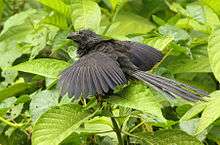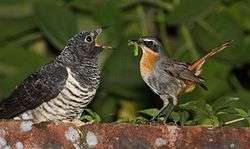Egg tossing (behavior)

Egg tossing or egg destruction is a behaviour observed in some species of birds where one individual removes an egg from the communal nest;[1] which is related to infanticide.[2] This behaviour is observed in avian species, most commonly females,[3] who are involved with cooperative breeding or brood parasitism.[1] Among colonial non-co-nesting birds, egg-tossing is observed to be performed by an individual of the same species. Tossing of eggs is non-accidental: the intruder rolls the egg to the edge of the nest by repeatedly flicking it with its beak.[4] During co-nesting, before a bird starts laying its own eggs, it tosses out other eggs laid previously by another female. As a result, the last egg-layers may contribute more eggs to the common nest:[5] this will increase the chances that newly laid eggs bearing the genetic material of that female will have a better chance of survival.[6][7] In some species, egg-tossing is a strategy of clutch coordination: eggs are tossed until all birds in the common nest are ready to proceed with brooding. Preventing early egg-layers from dominating reproduction.[6][5] Laying eggs late can be detrimental to the offspring once the egg is hatched since it will be smaller than their siblings thus increasing the risk of death.[2][3] Performing this behaviour increases the offspring per individual compared to those in single pairs and many species have learnt to adapt to increase the chances of their offspring to survive.[7]
Species that display this behaviour
Some examples of communal breeders that demonstrate the egg tossing behaviour are: ostriches, grooved-bill anis, acorn woodpeckers,[8] the gray-breasted jay,[7] the guira cuckoo and smoothed-bill anis.[3]
Advantages and disadvantages
Advantages
In communal breeding there are multiple females in a group. This has shown that the number of eggs produced per individual is greater in comparison to single female groups.[3] Reasoning behind this is due to the higher competition between females: to have their own eggs be successfully hatched and from the large amount of egg loss.[3]
The acorn woodpecker showed that when in a group of 7-8 individuals, the success rate of reproduction increased, but would decrease if more members joined the group.[7] When there were two females in the clutch the success would decrease compared to a single female clutch; since there is a higher competitive and conflict rate.[7]
In the guira cuckoo, up to 7 females share a nest and perform egg tossing behaviour. Eggs that are laid in the early period of production are more likely to be tossed out of the nest by another female.[3] When the group size increases, the egg tossing behaviour does not increase.[3]
Disadvantage
Laying eggs late prevents that individuals eggs being tossed out of the nest, but can have a negative impact on the offspring. Late egg laying causes later hatching which increases the probability of death.[3][2] These late chicks will be smaller than their nest mates, putting them at risk.[3][2]
Adaptation
In the acorn woodpecker it has been observed that due to the egg destruction behaviour it causes the egg laying to be synchronized between females. This synchronization of egg laying allows for all females to have the same opportunity to have a similar number of eggs in the nest.[8] The larger the communal breeding group is the longer it takes for the synchronization to occur.[8]
_(14563584419).jpg)
Ostriches are usually found in a group of two to seven and there is only one major hen which will incubate the nest with the single male. The female ostriches will lay their eggs at the same time, leading to having too many eggs in the nest.[2] The major hen is able to detect which eggs belong to her and will push the other eggs on the perimeter of the nest, which is not looked after. This adaption of abandoning these eggs protects the well kept eggs from predators.[2]
In the grooved bill anis and in the guira cuckoo, these species will stop tossing eggs once they have started to produce eggs in the nest. This behaviour prevents them from unknowingly toss one of their own eggs out of the nest.[3]
Egg tossing by brood parasites
A slightly different behaviour is that of brood parasite birds, such as some species of cuckoos.[9] There are two types of brood parasitism, one which the females lay their eggs in the nest of the same species or different species.[10]

The common cuckoo watches the nest of a potential host. Once the host leaves the nest the female cuckoo will remove one of the hosts eggs and will replace it with one of hers.[9] The female cuckoo will have no part in taking care of her offspring; she will leave the host's nest and look for another nest which she can lay another egg.[9]
There are different methods that brood parasites trick the host in raising their child, however some host's have developed counter adaptations to these.[9] The adaptation between the host and brood parasites is an example of co-evolution.[9]
Species
Several species of cuckoos and cowbirds.[9]
References
- 1 2 Lyon, Bruce E; Shizuka, Daizaburo (November 2010). "Communal breeding: Clever defense against cheats". Current Biology. 20 (21): R931–R933. doi:10.1016/j.cub.2010.09.056 – via Elsevier.
- 1 2 3 4 5 6 Hausfater, Glenn (2017-07-12). Infanticide: Comparative and Evolutionary Perspectives. Routledge. ISBN 9781351512619.
- 1 2 3 4 5 6 7 8 9 10 Schmaltz, Gregory; Quinn, James S.; Lentz, Cindy (2008-07-01). "Competition and waste in the communally breeding smooth-billed ani: effects of group size on egg-laying behaviour". Animal Behaviour. 76 (1): 153–162. doi:10.1016/j.anbehav.2007.12.018.
- ↑ 22-, Brown, Charles Robert, 1958 September (1996). Coloniality in the cliff swallow : the effect of group size on social behavior. Brown, Mary Bomberger. Chicago, IL: University of Chicago Press. ISBN 0226076253. OCLC 33667934.
- 1 2 Cooperative breeding in birds : long-term studies of ecology and behavior. Stacey, Peter B., Koenig, Walter D., 1950-. Cambridge: Cambridge University Press. 1990. ISBN 0521378907. OCLC 19670907.
- 1 2 Ecology and evolution of cooperative breeding in birds. Koenig, Walter D., 1950-, Dickinson, Janis L., 1955-. Cambridge: Cambridge University Press. 2004. ISBN 0521530997. OCLC 144618428.
- 1 2 3 4 5 "Cooperative Breeding". web.stanford.edu. Retrieved 2017-10-18.
- 1 2 3 Brown, Charles R.; Brown, Mary Bomberger (1988). "The Costs and Benefits of Egg Destruction by Conspecifics in Colonial Cliff Swallows". The Auk. 105 (4): 737–748. doi:10.2307/4087387. JSTOR 4087387.
- 1 2 3 4 5 6 Stevens, Martin (2013-10-21). "Bird brood parasitism". Current Biology. 23 (20): R909–R913. doi:10.1016/j.cub.2013.08.025.
- ↑ Robert, M. (2001-03-01). "The evolution of obligate interspecific brood parasitism in birds". Behavioral Ecology. 12 (2): 128–133. doi:10.1093/beheco/12.2.128. ISSN 1045-2249.